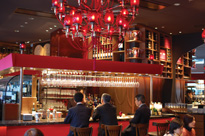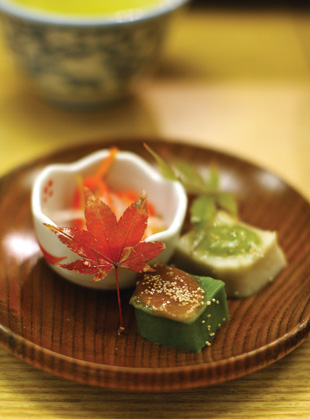Robb Satterwhite, a native of Manhattan and graduate of Columbia University, has written extensively on Japanese food, publishing three books on the subject. During his long tenure in Japan, he has penned countless restaurant reviews for his popular Web site, Bento.com, which covers the dining scene in Tokyo and other major Japanese cities and offers food-related travel features and Japanese recipes. Satterwhite currently lives in Tokyo’s Shibuya ward.
Why did you originally publish “What’s What in Japanese Food” in 1988?
Well, the primary goal was to introduce Japanese specialty cuisines to the world. Often otherwise-sophisticated gourmets will come to Japan and simply look for the best sushi bar, or they’ll book tables at a string of expensive kaiseki (traditional multi-course) restaurants that they found in a certain French restaurant guide; maybe in between they’ll visit a funky ramen shop. And that’s a shame, because they’ll be missing out on the incredible variety that Japanese restaurants can offer. Another goal is to allow visitors or foreign residents of Japan to actually order from Japanese menus on their own. And that was the original impetus for writing the book — it started out as a simple Japanese menu-reading guide. We even talked about the idea of publishing it as a box of flashcards rather than a book, although as the scope expanded that idea quickly became impractical.
This January you released the third edition — how has it been updated?
This new edition is a very thorough revision, with extensive rewrites of nearly every original chapter plus lots of new content (It’s also gotten bigger — from 180 pages to 256). It’s also organized more cleanly to make the content more accessible. For example, the first section of the book covers seafood cuisines like sushi, tempura, fugu, unagi (eel) and so on. Rather than having duplicate lists of fish that might be served in different restaurants, it includes a comprehensive “Fish and Seafood Quick Menu Reference” with over 120 entries, telling you which fish are served as sushi, as sashimi, grilled, tempura-fried and so on. The next section covers meat-centered cuisines, with an introduction to premium, name-brand meats like Kobe and Matsuzaka beef, Kurobuta pork, etc.
There’s a new section covering sake, shochu and other Japanese drinks — how to find the good stuff and how to order it. There are new chapters devoted to ramen, Japanese curry, takoyaki, and Okinawan cuisine. The Japanese food glossary has been expanded and now has more than 800 entries, including some more regional terms that you might run into when traveling outside Tokyo. My editor also suggested adding “expert tips” for each type of cuisine and I think those will really add to the reader’s experience.

What were you most surprised by looking back at the original?
I had forgotten how hard it was to get a decent drink in Japan 20 years ago. We didn’t have all the wine bars and Belgian beer bars and craft-sake pubs we have today, and you really had to go out of your way to get even a simple vodka-based cocktail. The entire section on drinking in Japan had to be rewritten from scratch.
How has the dining scene changed since the first version came out?
The restaurant scene is far more sophisticated than it was 20 years ago, and Tokyo has really become a world-class restaurant city. Today there’s much more emphasis on premium ingredients — heirloom breeds of chicken and game birds, heirloom vegetables, name-brand pork and much better craft sake and shochu from small, regional breweries.
Izakaya pubs used to be rustic places with a big red lantern and a statue of a badger outside, where you could order fairly standard dishes and your choice of hot or cold sake. Nowadays we have dining bars with gorgeous interiors, creative original cuisine, and serious sake and wine lists. Cramped, smoke-filled coffee shops serving over-priced coffee have been replaced by cute little cafes with comfortable chairs, hip music and decent, affordable food. I’d say the restaurant scene here has gotten better in every way.
How have your dining habits or tastes changed?
Since I publish the Bento.com guide, I probably eat in a wider variety of places than I used to. Among other things, I’ve come to appreciate the subtle charms of Japanese curry, a cuisine I never quite understood the attraction of before.

How does the new edition reflect the growing interest in Japanese food?
There’s certainly a great deal of interest, but I think people around the world associate Japanese food with specific dishes like sushi or Kobe beef or whatever. So in the book I’ve tried to add to people’s appreciation of the food by filling in the background, explaining the fundamental philosophies behind Japanese cuisine. For example, when you understand the importance of seasonality you can appreciate the appearance of a certain ingredient on your plate as signaling the coming of spring or fall or whatever. When you learn about the art of presentation, you might notice that a round piece of food will be served to you on a square dish and vice versa.
What other books about Japanese food would you recommend?
“The Book of Sake: A Connoisseur’s Guide” by Philip Harper is very informative and beautifully put together. I learned a lot about kaiseki while reading “Kaiseki” by Yoshihiro Murata. And “Cool Tools: Cooking Utensils from the Japanese Kitchen” by Kate Klippensteen is a fun read.









